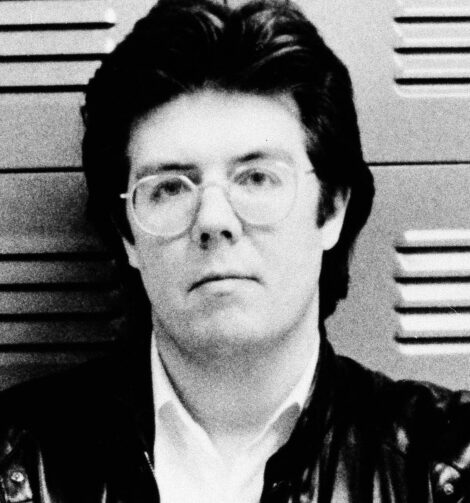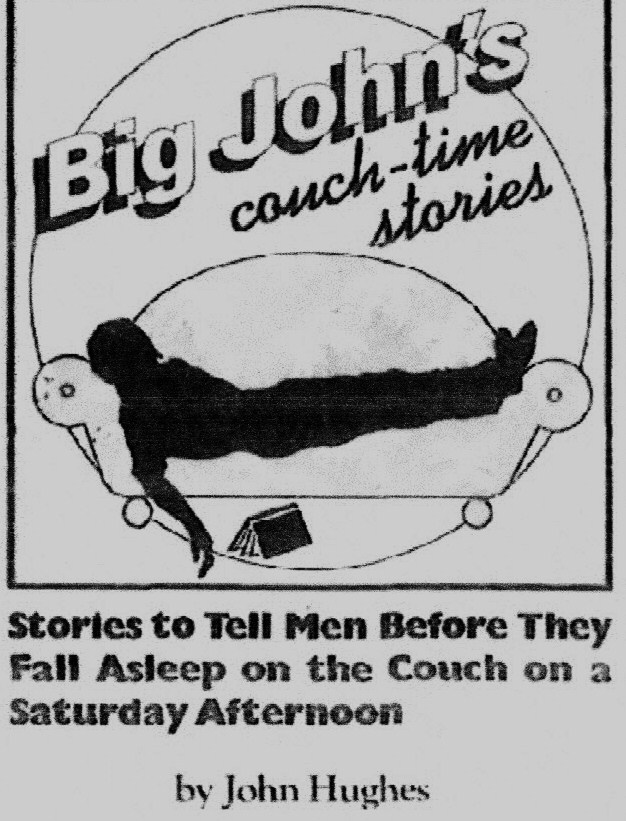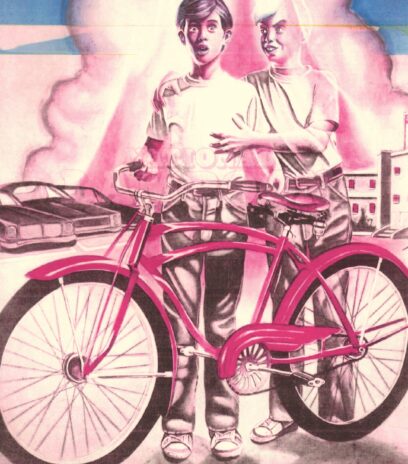 In the unnerving 1980 short story “Boy’s Wrath” a teenager embarks on a violent campaign of vengeance against those he feels have wronged him, guided by a hallucinatory twin. With its perceptive view of adolescence and relentlessly bleak trajectory, you might say “Boy’s Wrath” reads like an evil take on a John Hughes movie, yet the story was written by the same John Hughes who scripted and/or directed the much-loved eighties teen comedies SIXTEEN CANDLES, THE BREAKFAST CLUB and PRETTY IN PINK, as well as the nineties kid flicks HOME ALONE and CURLY SUE.
In the unnerving 1980 short story “Boy’s Wrath” a teenager embarks on a violent campaign of vengeance against those he feels have wronged him, guided by a hallucinatory twin. With its perceptive view of adolescence and relentlessly bleak trajectory, you might say “Boy’s Wrath” reads like an evil take on a John Hughes movie, yet the story was written by the same John Hughes who scripted and/or directed the much-loved eighties teen comedies SIXTEEN CANDLES, THE BREAKFAST CLUB and PRETTY IN PINK, as well as the nineties kid flicks HOME ALONE and CURLY SUE.
In those films “rebellion” was signified by ditching school to go to an art museum (in FERRIS BUELLER’S DAY OFF) and spending one’s college savings on a quiet evening at the Hollywood Bowl (in SOME KIND OF WONDERFUL), but make no mistake: the apparently mild-mannered Hughes had a dark side. This is evident in the scripts he wrote for HOME ALONE and its sequels, in which a pair of bungling crooks are manhandled in ways that in reality would kill a person several times over, and also BABY’S DAY OUT, which finds comedy in the sight of an infant burning a man’s crotch with a cigarette lighter.
To fully access Hughes’ nasty impulses, however, you’ll have to go back to his pre-Hollywood days of the late seventies and early eighties. It was then that he wrote for and co-edited NATIONAL LAMPOON magazine, contributing a wealth of comedic articles and photo montages—see “Strip Poker,” in which three couples decide to play that very game with disastrous results, and the self-explanatory “How Your Parents Had Sex”—as well as several short stories.*
The most famous of Hughes’ LAMPOON stories are of course “Vacation ‘58” and “Christmas ‘59” (which provided the impetus for NATIONAL LAMPOON’S VACATION and NATIONAL LAMPOON’S CHRISTMAS VACATION). Both are laudable pieces of affectionate comedy (plus “Vacation ‘58” contains the none-too-happy ending that was cut from the movie), as are the porny “My Penis” and “My Vagina,” the first about a teenage girl who grows a penis and the second about a teen boy who finds he has a vagina.
Yet a far darker sensibility is evident in a 1979 editorial entitled “A Message from John Hughes to the Unemployed, the Sick, the Infirm, the Widowed, the Orphaned, the Disturbed, the Handicapped, the Downtrodden, and All You Other Grumps,” in which he claims that “I’m a fool if I think I can conceal the fact that my life is bent and twisted” and “If I wasn’t such a Jell-O-spine, I’d go suck on a .38” (said editorial, FYI, appears in the “Depression” issue).
Unemployed, the Sick, the Infirm, the Widowed, the Orphaned, the Disturbed, the Handicapped, the Downtrodden, and All You Other Grumps,” in which he claims that “I’m a fool if I think I can conceal the fact that my life is bent and twisted” and “If I wasn’t such a Jell-O-spine, I’d go suck on a .38” (said editorial, FYI, appears in the “Depression” issue).
A similarly twisted sensibility is present in “Against His Will,” which appeared in Hughes’ “Big John’s Couch-Time Stories” column. In it an ugly fat woman endeavors to rape a man at gunpoint—in full view of the guy’s wife and parents—because she can’t get laid any other way. Another “Big John” entry involves a man mounting a talking goat in the belief that the animal is Elke Sommer in the guise of an animal.
Keep in mind that neither story can be called great, or even particularly good. John Hughes was simply not what you’d call a prose stylist, which is evident in his hasty and at times clumsy writing. In a 2008 essay on “Vacation ‘58” Hughes admitted to his shortcomings as a fiction scribe, claiming he related the tale in the voice of a young boy to “cover up my lack of skill.” Nonetheless, there’s no denying the fertile wit and imagination on display.
In the mean-spirited “Halloween Rampage” a man recounts some particularly outrageous Halloween pranks he pulled when he was younger, many of which involved a homemade dummy doused with fake blood. Then there’s the downright Kafkaesque “A Dog Tale,” told from the point of view of a kid witnessing his mother’s transformation into a dog. The tale is a powerful bit of surreal fantasy that actually takes its premise fairly seriously, right down to the justly downbeat conclusion.
“The Spy who Wore Nothing” is in many respects a dry run for Hughes’ PG-rated 1985 flick WEIRD SCIENCE, but the story explores areas the movie—about nerds who create a sex goddess they eventually forsake in favor of mature relationships with nice girls—never approached. It involves the nerdy teenager Chuck, who after being humiliated by his dream girl is approached by an even dreamier woman, a sexy government agent who never wears clothes. She wants nothing more than to have wild sex with Chuck and help him attain his dreams, which naturally involve spraying Chuck’s high school with gunfire and then blowing it up.
This brings us full circle to the fearsome “Boy’s Wrath,” the most unnerving of all Hughes’ tales. It appeared in NATIONAL LAMPOON’S appropriately monikered April 1980 “Vengeance” issue, which featured one of the mag’s most politically incorrect covers. As for the story, if it contains any humor it’s of the darkest imaginable hue.
It pivots on the disgruntled Byron, who is approached one day by a twin claming to be “the insane part of you that comes out when you’re real mad.” The kid quickly talks Byron into drowning the neighbor’s hated dog, assaulting his sister at the dinner table and smashing his crotchety history teacher over the head with a book. From there Byron’s sadism grows increasingly elaborate, foreshadowing the intricate pratfalls of HOME ALONE and its ilk (as well as FIGHT CLUB). However, the nastiness here is far more impacting, involving a lawn mower positioned to fall on the head of a drunk neighbor and gasoline soaked into car seats. Byron’s rampage is eventually halted and he somehow grows up to be an upstanding citizen with a wife and three kids. But then one New Year’s Day Byron’s malevolent twin makes a return visit…
that comes out when you’re real mad.” The kid quickly talks Byron into drowning the neighbor’s hated dog, assaulting his sister at the dinner table and smashing his crotchety history teacher over the head with a book. From there Byron’s sadism grows increasingly elaborate, foreshadowing the intricate pratfalls of HOME ALONE and its ilk (as well as FIGHT CLUB). However, the nastiness here is far more impacting, involving a lawn mower positioned to fall on the head of a drunk neighbor and gasoline soaked into car seats. Byron’s rampage is eventually halted and he somehow grows up to be an upstanding citizen with a wife and three kids. But then one New Year’s Day Byron’s malevolent twin makes a return visit…
As if all that weren’t enough, Hughes accompanies the story with a four page collage entitled “My Revenge Folder.” Consisting of handwritten diatribes against various individuals the folder’s teenage author wants to kill accompanied by photos and drawings, it’s a genuinely skin-crawling document and, in these post Columbine/Newtown days, uncomfortably true to life. As with “Boy’s Wrath,” I fail to see much humor in this document, but it more than succeeds as an uncomfortably intimate glimpse into the mindset of a deranged teen—a teen, I’m certain, who could kick Ferris Bueller’s ass any day of the week.
*A humor magazine NATIONAL LAMPOON may have been, but it had much to interest horror fans. The macabre cartoons of Gahan Wilson are musts, as is the 1971 LAMPOON tale “War Hero” by David Chambourt, about a futuristic lottery whose winners are surgically disfigured so they can be paraded before the public as war heroes. Also appearing in the mag (and, to my knowledge, nowhere else) were Ted Mann’s 1975 “All Creatures, Even Bees,” concerning depraved veterinarians performing unspeakable acts on their animal patients, and P.J. O’Rourke’s 1980 “Ghosts of Responsibility,” which offered a surprisingly poignant account of a haunted house. Finally there’s Brian McCormick and Richard Rosomoff’s 1981 “Spilling Things on People,” a farcical confession by photographer Helmut Newton that concludes with the admission “Models are my medium; I do what I wish to them. And what I wish is to kill them and slit them open and spill their blood…”

